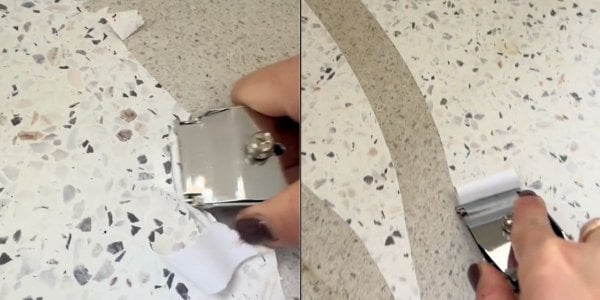Kmart Shoppers Beware: The Massive Rental Mistake You’re Likely Making – Read My Urgent Warning Before Your Next Visit!
By
Seia Ibanez
- Replies 4
As we age, we often find ourselves with a bit more time on our hands and a desire to spruce up our living spaces. It's no surprise that many of us become DIY enthusiasts, looking for quick, affordable ways to refresh our homes. Kmart Australia, with its array of budget-friendly home goods, has become a go-to for many looking to inject some new life into their homes without breaking the bank. However, a recent incident has highlighted a significant pitfall that Kmart shoppers, particularly those in rental properties, should be aware of.
An Australian mum, like many of us, was drawn to the allure of Kmart's adhesive wallpaper to revamp her kitchen countertop. The terrazzo-style adhesive film seemed like a perfect and inexpensive solution to give her kitchen a fresh look. However, when the time came to move out and remove the film, she was met with a 'disastrous' situation. The removal process turned out to be a nightmare, involving hours of painstaking labor with a scraper from Bunnings to peel off the vinyl and remove the sticky residue left behind.
The mum's experience serves as a cautionary tale for all of us, especially those in rental properties. Her warning is clear: 'Do not do this if you're in a rental property. I've spent three hours individually razor blading the s*** off, this is not fun.'
The online community had mixed reactions. Some criticized the decision to apply such a product to a rental property, suggesting it showed a lack of respect for the landlord's property. Others, however, sympathized with the mum's desire to improve her living space, especially if the rental was not in the best condition.
The incident raises an important point about the responsibilities of renters and the potential consequences of seemingly harmless DIY projects. It's crucial to remember that any changes made to a rental property should be reversible and not cause damage. Before undertaking any home improvements, it's wise to read through your rental agreement and, if in doubt, discuss your plans with your landlord.
For those who still wish to personalize their space without risking their bond, there are safer alternatives. Removable hooks, freestanding shelves, and furniture covers can all make a significant impact without leaving a trace.
If you do find yourself in a sticky situation with adhesive products, some community members suggested using heat, such as from a steamer or hairdryer, to loosen the glue and make removal easier. However, it's always best to test a small area first to ensure no further damage is caused.
Moreover, it's worth investing in higher-quality materials if you decide to go down the DIY route. As one commenter pointed out, 'You need the proper stuff, Kmart vinyl is no different to the stuff you put on books, you need vinyl that is made for benchtops, might cost more but worth it.'
In conclusion, while the temptation to use affordable and trendy DIY solutions from stores like Kmart is understandable, it's essential to consider the long-term implications, especially for renters. Always opt for non-permanent, non-damaging options to avoid a costly mistake that could take a toll on both your time and wallet.

Have you had a similar experience with a DIY project gone wrong? Or perhaps you've found a renter-friendly way to update your space? Share your stories and tips in the comments below – your advice could be invaluable to fellow members of the Seniors Discount Club!
An Australian mum, like many of us, was drawn to the allure of Kmart's adhesive wallpaper to revamp her kitchen countertop. The terrazzo-style adhesive film seemed like a perfect and inexpensive solution to give her kitchen a fresh look. However, when the time came to move out and remove the film, she was met with a 'disastrous' situation. The removal process turned out to be a nightmare, involving hours of painstaking labor with a scraper from Bunnings to peel off the vinyl and remove the sticky residue left behind.
The mum's experience serves as a cautionary tale for all of us, especially those in rental properties. Her warning is clear: 'Do not do this if you're in a rental property. I've spent three hours individually razor blading the s*** off, this is not fun.'
The online community had mixed reactions. Some criticized the decision to apply such a product to a rental property, suggesting it showed a lack of respect for the landlord's property. Others, however, sympathized with the mum's desire to improve her living space, especially if the rental was not in the best condition.
The incident raises an important point about the responsibilities of renters and the potential consequences of seemingly harmless DIY projects. It's crucial to remember that any changes made to a rental property should be reversible and not cause damage. Before undertaking any home improvements, it's wise to read through your rental agreement and, if in doubt, discuss your plans with your landlord.
For those who still wish to personalize their space without risking their bond, there are safer alternatives. Removable hooks, freestanding shelves, and furniture covers can all make a significant impact without leaving a trace.
If you do find yourself in a sticky situation with adhesive products, some community members suggested using heat, such as from a steamer or hairdryer, to loosen the glue and make removal easier. However, it's always best to test a small area first to ensure no further damage is caused.
Moreover, it's worth investing in higher-quality materials if you decide to go down the DIY route. As one commenter pointed out, 'You need the proper stuff, Kmart vinyl is no different to the stuff you put on books, you need vinyl that is made for benchtops, might cost more but worth it.'
In conclusion, while the temptation to use affordable and trendy DIY solutions from stores like Kmart is understandable, it's essential to consider the long-term implications, especially for renters. Always opt for non-permanent, non-damaging options to avoid a costly mistake that could take a toll on both your time and wallet.
Key Takeaways
- An Australian mother warns against using Kmart's adhesive wallpaper on kitchen countertops, especially in rental properties.
- After applying the terrazzo-style adhesive film from Kmart to her kitchen bench, she found it extremely difficult and time-consuming to remove when moving out.
- The DIY home improvement hack led to criticism from some who felt it showed a lack of respect for the landlord's property, while others defended it as an attempt to improve depressing rental spaces.
- Some commenters suggested using heat to assist in removing the adhesive film, while others criticised the product's quality and recommended purchasing better quality vinyl specifically designed for benchtops.
Have you had a similar experience with a DIY project gone wrong? Or perhaps you've found a renter-friendly way to update your space? Share your stories and tips in the comments below – your advice could be invaluable to fellow members of the Seniors Discount Club!








